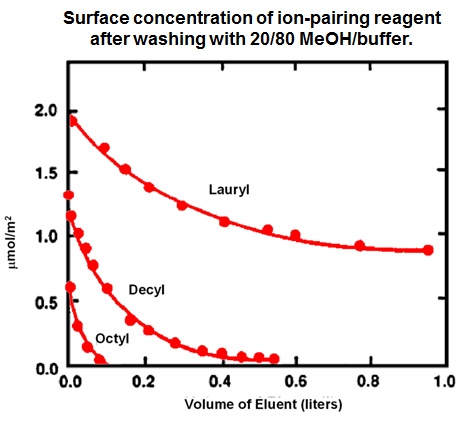A reader asks, “I am using a shared equipment where somebody used tetrabutyl ammonium (TBA) as an ion pair in their mobile phase for chromatography. It looks to me like the ion pairing reagent was not washed completely from the column, even though I flushed repeatedly with methanol (MeOH). Is there a way I can get rid of it?
Unfortunately, ion pairing reagents are about the “stickiest” stuff we can put into a column. For example, Figure 1 shows how fast various ion pairing reagents are washed out of the column. In this case [J. Chromatgr., 204 (1981) 3] the ion pairing reagent was removed from the normal mobile phase (20/80 methanol/buffer) and the column was washed with this solution. Even after 1 L of non-ion-pairing mobile phase passed through the column (equivalent to 400 column volumes!), a significant amount of ion pairing reagent remained, no matter which ion pairing reagent was studied. The authors state that it was impossible to wash all the lauryl sulfate off the column even with 100% methanol or isopropanol.
 Figure 1
Figure 1
The take-home message here is that once ion pairing reagents go in the column, they never come out completely. So columns should be dedicated to ion pairing once they have been used in this mode. Also, the slow wash-out is observed in the other direction, and it may take 20-50 column volumes or more to fully equilibrate the column. For this reason, I go against my usual advice of removing the mobile phase from the column before storage. With ion pairing methods, I suggest storing the column with the ion pairing mobile phase in the column. Yes, column life will probably be shorter, but that is likely the case with ion pairing methods anyway. Remove the column from the system, cap it tightly for storage, replace the column with a piece of tubing, and flush any remaining reagents from the pump(s), tubing, and detector before shutting off the HPLC system.
If you find that there still is residual ion pairing reagent in the rest of the system after removing the column and flushing with 100% methanol or isopropanol, it may be necessary to perform a more aggressive system flush. I suggest ≈30% phosphoric acid. First, flush the system with water to remove any residual organic solvent. Then dilute concentrated phosphoric acid 1:2 with water to make ≈30% of the original concentration. Flush 20-30 mL of this solution through all reservoir tubing lines, all degasser channels, and the rest of the system (pump, autosampler, detector). Finally, flush thoroughly with water to remove any residual acid. You can monitor the removal of the acid by checking the pH of the water exiting the detector; 50 mL of water is likely to be sufficient.
This blog article series is produced in collaboration with John Dolan, best known as one of the world’s foremost HPLC troubleshooting authorities. He is also known for his research with Lloyd Snyder, which resulted in more than 100 technical publications and three books. If you have any questions about this article send them to TechTips@sepscience.com




